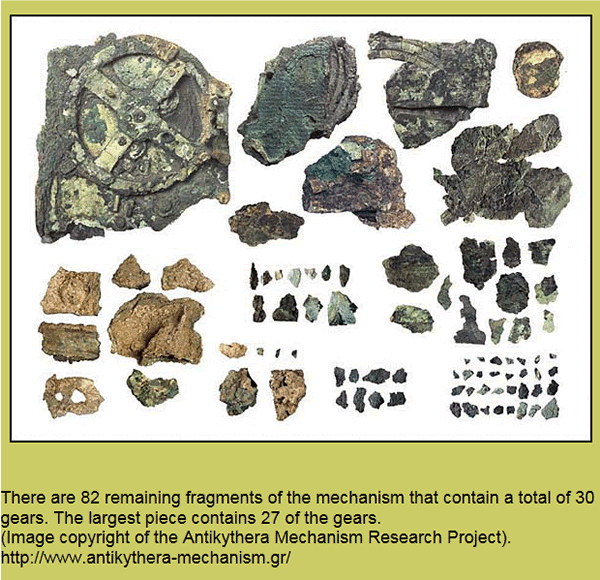The Antikythera Mechanism discovery
 Sometime before Easter 1900 a Greek sponge diver discovered the wreck of an ancient cargo ship off Antikythera
island which is located to the north-west of Crete in the Dodecanese.
Sometime before Easter 1900 a Greek sponge diver discovered the wreck of an ancient cargo ship off Antikythera
island which is located to the north-west of Crete in the Dodecanese.Divers subsequently retrieved several bronze and marble statues and other artifacts from the site.
The interest of the professional archaeologists brought in to conserve and assess the finds was initially centered on the fine statuary and the Antikythera Mechanism itself was only discovered to be of immense interest in May 17, 1902, when an archaeologist noticed that a piece of rock recovered from the site had a gear wheel embedded in it. Examination revealed that the "rock" was in fact a heavily encrusted and corroded mechanism that had survived the shipwreck in three main parts and dozens of smaller fragments. The device itself was surprisingly thin, about 33 cm (13in) high, 17 cm (6.75in) wide and 9 cm (3.5in) thick, made of bronze and originally mounted in a wooden frame.
The Antikythera mechanism is one of the world's oldest known geared devices. It has puzzled and intrigued historians of science and technology since its discovery. The device seemed to have a range of interlocking gears made of bronze and a hand crank to give a turning movement to the geared mechanism, plus a display that showed information about the moon, sun and planets against a background of stars.
Following decades of work cleaning the device, in 1951 British science historian Derek J. de Solla Price undertook systematic investigation of the mechanism. In June 1959, Price's "An Ancient Greek Computer" was the lead article in Scientific American. This article was the result of the first thorough description of the device "based solely on visual inspection and measurements."
The Antikythera Mechanism is strongly suggestive of an ancient Greek tradition of complex mechanical technology which, transmitted via the Arab world, formed the basis of European clockmaking techniques.
Another, smaller, device dating from the sixth century AD, has been discovered which models the motions of the sun and moon and provides a previously missing link between the Antikythera mechanism and later Islamic calendar computers, such as the 13th century example at the Museum of the History of Science in Oxford. That device, in turn, uses techniques described in a manuscript written by al-Biruni, an Arab astronomer, around 1000AD.

The device was too fragile to be removed from its home at the National Archaeological Museum of Athens, so the Antikythera Mechanism Research Project team constructed a 12-ton portable micro focus computerized tomographer that used high resolution X-rays to probe the object and create a 3-dimensional image.
A reinterpretation of the function of the various fragments by Michael Wright of Imperial College London developed between 2002 and 2005 arrived at an entirely different assembly for the gears than previously thought.
Wright's reconstruction of the device, with 72 gears, suggests it may have been an orrery that was intended to mechanically demonstrate the motions of the five planets known to the Greeks of the time.
Taking all the available facts into account, the prevailing theory at the moment is that the device was a clockwork-like mechanism designed to display the progress and positions of the sun, moon, and probably all five of the other planets known at the time (Mercury, Venus, Mars, Jupiter, and Saturn) over a period of 19 years. In other words: it's an analog astronomical computer. It had apparently been built several years before the shipwreck - most likely in 82 B.C.
In 2006, the Project announced that with the aid of tomography almost 95 percent of the text engraved on the various parts of the device is now readable, giving scientists a much-improved understanding of its capabilities.
The mechanism is now considered to have been an analog computer designed to allow the operator to "mechanically" predict the future or past positions of the sun, moon, and probably some of the planets through the turning of a handle on the side of the mechanisms case which caused the internal gearing to turn imparting motion to hands on readable dials.

On the front of the device were two dials marked with the zodiac and a solar calendar, with pointers for the Sun and Moon plus a display showing the phase of the moon. On the rear of the object was displayed information about the Saros cycle (a period of around 18 years used in eclipse prediction) and the Callippic cycle (a period of about 76 years) using two ingeniously designed spiral dials.
The makers of the Antikythera Mechanism - from the Ancient World as they were! - seem to have accepted that the Sun was at the centre of an orbital system, - anticipating Copernicus and Galileo by some fifteen hundred years.
The device uses a differential gear, previously believed to have been invented in the middle ages, and is remarkable for the level of miniaturization and complexity of its parts, which is comparable to that of 18th century clocks. It is probable that the Antikythera mechanism was not unique. Cicero, writing in the 1st century BC, mentions an instrument "recently constructed by our friend Posidonius, which at each revolution reproduces the same motions of the sun, the moon and the five planets."
The levels of precision and astronomical understanding necessary to the functionality of the antikythera Mechanism perhaps attest to the strong possibility that this example of ancient genius in mechanics and science was not unique and that its designers and fabricators were capable of producing other examples of such, or similar, instruments.
Check out this you tube video clip:-
